DO-IT News February 2015

Volume 23, Issue 1
Below are the articles of the DO-IT News February 2015 newsletter. These articles can also be seen all on one page at the Full Newsletter option.
Director's Digressions: DO-IT Goes Down Under
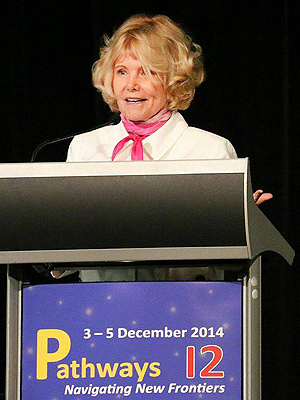
More than 20 hours in the air took me to what author Bill Bryson calls the most remote city on earth—Perth, Australia. He justifies this distinction by noting that the population of metropolitan Perth is greater than the combined populations of the rest of Western Australia, the Northern Territory, and South Australia west of Adelaide.
My destination was the historical Esplanade Hotel in Fremantle, a small port located on the Swan River on the outskirts of Perth. What a beautiful place—and, in December 2014, it was summer there.
The purpose of my trip was to deliver the keynote address at the Pathways 12 Conference, which each year brings together professional and academic staff to identify and remove barriers for people with disabilities participating in higher education. “Navigating New Frontiers” was the theme for the 2014 conference. Organizers selected this focus because, in this field of practice in Australia and around the world, we are constantly exploring new frontiers in providing access to people with disabilities. This includes adopting more innovative and universal practice models, maximizing access to emerging technologies, and adapting to changes in legislation and policy.
In my keynote address, “Universal Design: How do students with learning disabilities benefit?” I talked about universal design of instruction, a teaching approach that makes learning activities more welcoming and accessible to all students, including those with various types of disabilities, as well as gender, culture, race, ethnicity, age, and other characteristics. I shared how universal design practices can benefit students with specific learning disabilities in particular. The keynote was followed up with a concurrent session where interested attendees could continue the conversation on universal design.
I also delivered a half-day preconference workshop, “Putting Universal Design Into Practice,” at nearby Curtin University, which boasts a student body of 75,000 students. Participants learned about access challenges students with disabilities face, approaches for making educational products welcoming and accessible to everyone, and basic principles of universal design. Together, we explored how specific universal design strategies can be applied to technology, physical spaces, instruction, and student services.
As with all of my travels, I enjoyed engaging with people with a similar goal to increase the success of students with disabilities. I shared ideas and brought home ideas that will inform DO-IT activities as well. I even managed to take some extra time to explore the warm beaches, waterfront, and city of Perth.
If you would like to learn more about how universal design can be applied in educational settings, check out DO-IT’s Center on Universal Design in Education (www.uw.edu/doit/programs/center-universal-design-education/overview), which was originally funded by the U.S. Department of Education.
Ambassador Profile: Conrad Reynoldson
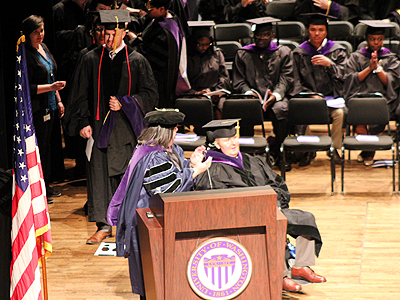
Helen Keller once said, “Alone we can do so little; together we can do so much.” This truth has certainly been apparent throughout my life, educational experience, and beyond.
My name is Conrad Reynoldson. I am a recent graduate of the University of Washington School of Law, a licensed attorney, and a DO-IT Scholar (2003-2005). I consider myself blessed to have been born during the Information Age, have access to technology, and be a part of the DO-IT program. I am excited about the doors that DO-IT participation and technology will open for many of those reading this story.
I joined the DO-IT program feeling uncertain about how I would transition from high school to college but excited that the program would introduce me to new technology that would help make that transition easier. What I didn’t expect from the program was the community of people filled with hopes and dreams, sharing the tools and knowledge needed to overcome our individual barriers.
DO-IT provided me with a laptop and printer, gave me my first on-campus living experience, and connected me with my first internship at the Federal Aviation Administration (FAA). For these reasons and more, DO-IT played a pivotal role in making a full college experience, as well as a career in law, a realistic option for me. Being part of a community of determined and successful individuals, who also happened to have a disability, gave me confidence that I could live an even bigger life than I had imagined. I can still remember coming home after my first DO-IT summer and announcing to my parents that I no longer wanted to be a “commuter” when I went to college. I wanted to live on campus.
In addition to the educational experiences, I have had numerous career opportunities that would have never happened without DO-IT originally opening the door. I have had various internship experiences: with a Senator in Washington, D.C., a Congressman in Washington state, prominent think tanks in Seattle and Washington D.C, and with Disability Rights Washington in Seattle.
When I reflect on my undergraduate and law school experience, sitting for the Bar exam, and how I am now practicing law, I realize how fortunate I am to have been born in the era of technology. My physical limitations are not limitations for my chosen career path. All of my textbooks were available in electronic form, every piece of legal research material I need is accessible with a few key strokes, my legal filings can be written using speech-to-text technology very efficiently, and I can communicate with my co-counsel and client anytime, anywhere via cell phone, Skype, and email.
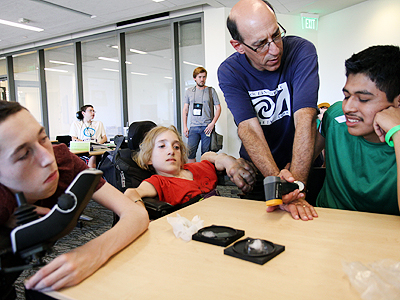
For as long as I can remember, I have had an interest in public policy and serving the needs of the underrepresented. While the Americans with Disabilities Act is a very positive first step toward removing physical barriers for people with disabilities, we have not seen substantial improvement in employment statistics since. I believe that public policy has not kept pace with changes in society and technology and that, in many cases, well intended programs are creating unnecessary barriers for people with disabilities to access employment. This reality is the primary reason why I decided to be a member of the Governor’s Committee on Disability Issues and Employment (GCDE) as well as a chair of their Employer Awards subcommittee. Scott Bellman, a long serving member of DO-IT staff, has been involved with GCDE for many years and was the one who connected me with this opportunity.
Many of the DO-IT Scholars I’ve met over the past decade have grown up to become successful professionals in countless fields. DO-IT has been an important step in providing the tools, confidence, and community support we needed to live up to our full potential.
As of now I am working as a licensed attorney and have a world of career possibilities in front of me. I have my experience with DO-IT in part to thank for helping turn my aspirations into a reality. DO-IT shaped my dream of pursuing a college education and career from a broad aspiration to a challenging but concrete and possible goal.
Mentor Day Activity
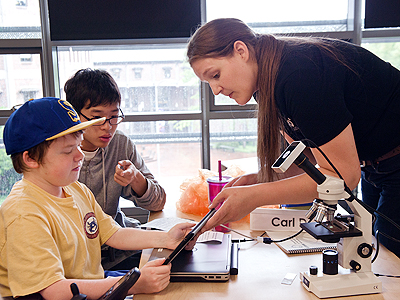
A group of Cleveland High School seniors participated in Mentoring Day at Seattle Children’s Hospital on December 14, 2014. The students interacted with personnel and learned about educational requirements, personality traits, and skill sets recommended for jobs within healthcare.
Staff working in maintenance/horticulture, emergency, dietary/nutrition, labs, nursing, reception, and security shared their stories, including how they came to work at Seattle Children’s. The students repeatedly heard that the staff knew their first responsibility was to the patients and their families. As the day progressed, students could decide if this environment was a good fit for them.
“This trip was particularly important for them to get an idea of what the healthcare field offers and if they are truly cut out for the work it demands,” their teacher stated. “I really can’t say enough positive things about the impact the trip had on my students! One student in particular was very confused before the trip and going back and forth between which healthcare certificate or degree she wanted to pursue. When I spoke with her this morning she told me that she wants to pursue a lab technician certificate/degree and we are going to explore community college options in January together. A huge thank you is in order for the trip to Seattle Children’s Hospital!”
Attending Conferences via Robots
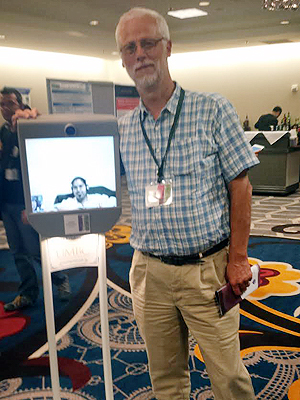
Attending the 2014 ACM International Joint Conference on Pervasive and Ubiquitous Computing (UbiComp 2014) in Seattle, Washington via the Beam Telepresence Robot was a memorable experience. Although I was unable to attend the conference in person, I participated in a user study, which provided me the opportunity to attend and interact with other attendees remotely. The telepresence initiative user study was organized by the Co-Chairs Dr. Carman Neustaedter, from Simon Fraser University in Canada, and Gina Venolia, from Microsoft Research.
The Beam robot, created by Suitable Technologies, allowed me to have mobility by using a wheeled battery powered device with voice conferencing and telepresence capabilities. The Beam includes two wide-angle cameras, a six-microphone array with echo-canceling and noise reduction, a seventeen inch LCD screen, an eight hour-battery, two dual-band radios providing Internet connectivity, and a built-in speaker coupled to a mobile platform. The Beam has great maneuverability and can be driven using a mouse, keyboard, or Xbox controller. Participants were also given the option to personalize their Beam robot with a label that displayed their name and contact information.
I had the opportunity to meet amazing researchers from across the country as well as individuals from China, England, Sweden, and Italy and engage in discussions about varied and interesting research projects as a bridge to meaningful mentorship and guidance. Although I have spoken with Dr. Richard Ladner via phone, Skype, and email for over ten years, it was exciting and gratifying to meet him for the first time physically, albeit in virtual space, thanks to the Beam robot.
Using the Beam robot provided a sense of dynamic and real-time presence in the actual conference environment. It was great to be able to join discussions after the presentations, and I enjoyed having autonomy and independence while driving and operating the Beam robot.
Nevertheless, the experience wasn’t perfect. I would often lose Internet connection inside the elevator and between presentation sessions when there was significant traffic on the network. Other challenges included audio and video problems. For example, feedback from my microphone caused disturbances in the sound quality, so I had to frequently adjust the volume on the microphone. Although I felt totally immersed and connected at the sessions of the conference, I had a sort of “jet-lag” because of the time difference between Maryland and Seattle, and I felt a sense of disconnect because of the differences between my home and the conference site.
I look forward to attending future conferences using the Beam robot or similar technology. In fact, as a result of the UbiComp 2014 conference experience, I was able to work with AccessComputing to remotely attend the International ACM SIGACCESS Conference on Computers and Accessibility (ASSETS), which was held in Rochester, NY using a Beam robot. For someone who is unable to travel to professional conferences, these two experiences were unparalleled.
Disability in the Media: Stella Young
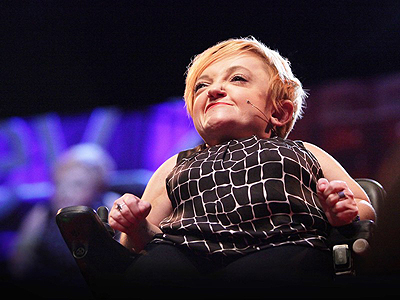
I want to make a space in my media series to recognize an influential disability activist who recently passed away in December 2014. Stella Young was a comedian, writer, and activist who believed in reshaping the way society views people with disabilities. She partnered with organizations such as the Victorian Disability Advisory Council, Youth Disability Advocacy Service, and Women With Disabilities Victoria. She was involved with many disability-related projects including Ramp Up, an online space about disability issues and No Limits, a show about disability culture in Australia.
I had not heard of Stella Young until her TED Talk started circulating on social media in June of 2014. Her talk was entitled “I’m not your inspiration, thank you very much.” My first impression of Stella was that she was young, incredibly funny, fashionable, and appeared to be completely comfortable in her own body, which happened to be in a wheelchair. I couldn’t help but laugh when she made a joke about Buffy the Vampire Slayer. I related to her, and, although I cannot claim to be all of those things, it was a reflection of what I wanted to be. Growing up I had very few role models to look up to who looked like me, and none that I actually connected with on a deeper level. Within minutes of watching her talk she became that person.
Her TED Talk was focused on how society objectifies people with disabilities as objects of inspiration, which she called “inspiration porn.” These images often portray an individual with a disability with text that reads: The only disability in life is a bad attitude. Stella stated that the purposes of these images are to “objectify disabled people for the benefit of nondisabled people. They are there so that you can look at them and think that things aren’t so bad for you, to put your worries into perspective.” She talked about how society has such low expectations of disabled people that everyday activities such as getting on the bus is praised. These low expectations are often verbalized by non-disabled with the best intentions engaging people with disabilities out in public. People want to be inspired and recognize the hardships others have, but in doing so it perpetuates the “otherness” label that many minorities are given.
In response to the question of people with disabilities being inspirational, she explained: “I learn from other disabled people all the time. I’m learning not that I am luckier than them, though. I am learning that it’s a genius idea to use a pair of barbecue tongs to pick up things that you dropped. I’m learning that nifty trick where you can charge your mobile phone battery from your chair battery. Genius. We are learning from each others’ strength and endurance, not against our bodies and our diagnoses, but against a world that exceptionalizes and objectifies us.” People with disabilities are overcoming more than just their diagnoses but the stigma of society around them. They show resilience and innovation in navigating a world of inaccessibility, stigma, and discrimination.
Watch Stella’s TED Talk, which has been viewed more than one and a half million times, at www.ted.com/talks/stella_young_i_m_not_your_inspiration_thank_you_very_much. The video includes captions and a full transcript.
To learn about some of the projects Stella supported, visit the Disability Media Australia website at https://pwd.org.au/resources/library/media/
Resume Tips and Contest
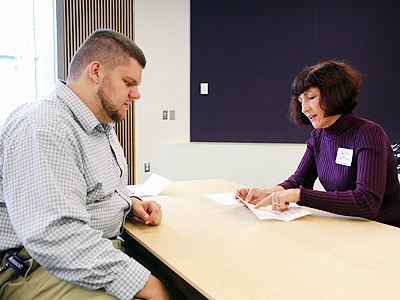
Throughout the year, AccessSTEM Team members hear about scholarships, internships, and other work-based learning opportunities through the discussion list at accessstem@uw.edu. This winter, one of those opportunities was a resume contest. Over sixty AccessSTEM Team Members submitted their resumes. All the resumes submitted were fantastic. Eleven lucky Team Members were chosen for prizes!
Team members can send their resumes to AccessSTEM staff for review or assistance any time of the year. We often get questions about what makes a good resume, so here are a few tips to make your resume stand out.
- Keep a master resume containing every work-related experience with contact information for all supervisors/managers. However, for each opportunity, create a resume with only experience and skills relevant to the job posting. Highlight what makes you perfect for the job.
- Rather than including an objective statement or reference list on your resume, devote more space to experiences related to the job you’re applying for and list your qualifications, skills, and accomplishments.
- Use the same key words found in a job posting on your resume. Mirroring this language makes it very easy for a recruiter or manager to conclude that you are a good fit for the position.
- Sell the benefits of your skills. Use engaging language that catches the reader’s attention. For example, instead of “Types 80 wpm,” write “Achieved top production volume by maintaining high degree of accuracy with typing a speed of 80 wpm.”
- They say a manager or recruiter only spends 30 seconds per resume—readability, easy organization, and only one or two simple, consistent fonts are important for getting your information across.
- Include programs like AccessSTEM CAREERS and AccessComputing on your resume to show that you are engaged in a nationwide program.
- Have someone else edit your resume before you submit it. Make sure that it is free of typos and well formatted.
- Title your document with your full name. Nine out of ten resumes submitted to the contest did not include the student’s full name, and three out of ten didn’t include any name or initials at all.
- Be sure your name and contact information appears on every page.
- If you save your resume as a PDF file, remember to tag headings and format it in an accessible manner so anyone can read it. More information on accessible PDF files can be found at www.uw.edu/doit/pdf-accessible.
For more information on getting ready for a career, consult Preparing for a Career: An Online Tutorial at www.uw.edu/doit/preparing-career-online-tutorial. You can also visit your campus career center in person or online for more tips on how to craft your resume.
Winners of this year’s resume contest were
- Kiara, for a well organized resume that clearly highlights her education, work experience, key skills, and awards.
- Neha, for a perfectly formatted resume.
- Lourdes, for a brief CV that still highlights all of her experience and qualifications in two concise pages.
- Patrick for an eye catching resume.
- Joseph and Deborah, for including AccessSTEM or DO-IT engagement on their resume.
- Andrew, for summarizing his summer internship projects.
- Zhengqi, for highlighting work he did on campus, demonstrating how he can balance work, school, and other activities.
- Jon and Caitlyn, for keeping comprehensive CVs that are still easy to navigate and digest.
- Erica, for highlighting the skills she took away from past work experiences that she would like to continue to pursue.
- Mihir, for making the most of a brief work history and articulately summarizing skills that future employers might look for.
Call For Articles: Next Review Cycle Begins March 15, 2015
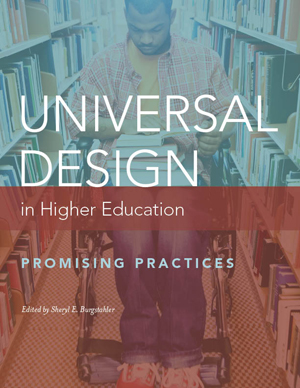
In DO-IT’s online publication, Universal Design in Higher Education: Promising Practices, practitioners share promising practices related to the application of universal design in postsecondary education settings. This collection of promising practices complements the more general content in the printed book, Universal Design in Higher Education: From Principles to Practice, published by Harvard Education Press (hepg.org/hep-home/books/universal-design-in-higher-education).
The new publication is available freely online at www.washington.edu/doit/resources/books/universal-design-higher-education-promising-practices. It can be freely copied and distributed as a book or in part for noncommercial, educational purposes. The collection will continue to grow as more articles are submitted.
Articles may be submitted at any time to udhecop@uw.edu. Submitted articles should include specific ways practitioners and researchers have applied universal design in postsecondary settings along with evidence of success. They are peer-reviewed by members of the Universal Design in Higher Education Community of Practice (udhecop@uw.edu), and if accepted, edited by DO‑IT. Articles selected for the online resource are freely available on our website. Authors must agree to these conditions while retaining copyrights to their individual contributions. For author guidelines, consult the preface of the book at www.uw.edu/doit/universal-design-higher-education-promising-practices.
How can you DO-IT?
- Sign up to receive DO-IT News if this newsletter was not mailed directly to you.
- Volunteer as a Mentor or to help with one of our Summer Study programs.
- Pass this newsletter on to someone you know who can benefit from our programs.
- Donate money to support and extend DO-IT activities including sponsoring Scholars from states outside of Washington, special events, work-based learning experiences, participant attendant or travel costs, refreshments for program participants, and creation and distribution of educational videotapes and publications.
DO-IT today by completing the form below! You may also make a secure online credit card donation at the University of Washington Make a Gift page by selecting the "DO-IT Program Gift Fund" option.
___ Sign me up to receive copies of DO-IT News, a free program newsletter.
___ Send me more information about DO-IT volunteer opportunities.
___ I would like to make a donation (payable to the University of Washington, Federal ID#91-6001537) to support DO-IT operations.
___ I have enclosed a check for $____________
___ Please charge $____________ to my credit card.
___ VISA ___ Mastercard
Date _____________
Card Number __________________________ Expiration Date _____________
Card Holder Name ___________________________________________________
Signature _____________________________________________________
Address ____________________________________________________________
City __________________________ State _____________ Zip ____________
Phone: Home __________________________ Business ____________________
E-mail: ____________________________________________________________
Your gift is tax-deductible as specified in IRS regulations. Pursuant to RCW 19.09, the University of Washington is registered as a charitable organization with the Secretary of State, State of Washington. For more information, call the Office of the Secretary of State, 1-800-322-4483.
Mail to:
DO-IT
University of Washington
Box 354842
Seattle, WA 98195-4842
Thank you!
The Browser: Calendar of Events
For a schedule of conferences, visit www.washington.edu/doit/resources/events
About DO-IT
DO-IT (Disabilities, Opportunities, Internetworking, and Technology) serves to increase the successful participation of individuals with disabilities in challenging academic programs and careers, such as those in science, engineering, mathematics, and technology. Primary funding for DO-IT is provided by the National Science Foundation, the State of Washington, and the U.S. Department of Education.
For further information, to be placed on the DO-IT mailing list, or request this newsletter or other materials in an alternate format, contact:
DO-IT
University of Washington
Box 354842
Seattle, WA 98195-4842
doit@uw.edu
www.uw.edu/doit/
206-685-DOIT (3648) (voice/TTY)
888-972-DOIT (3648) (toll free voice/TTY)
509-328-9331 (voice/TTY) Spokane
206-221-4171 (fax)
Founder and Director: Sheryl Burgstahler, Ph.D.